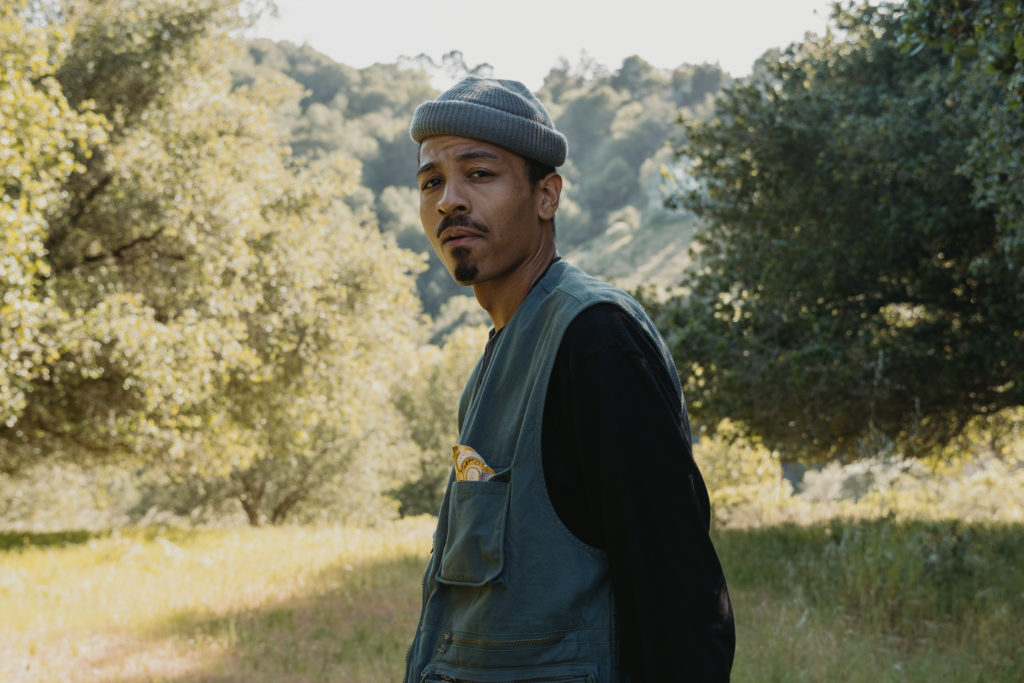The “triple lindy” is a physics-defying dive composed of multiple flips completed between several diving boards. Rodney Dangerfield, comically unfit and forever disrespected, “completes” it (with stunt-double assistance and cutaways) in the 1986 comedy Back to School. Unlike Dangerfield, Sndtrak has garnered seemingly ubiquitous respect for his neck-breaking, jaw-dropping flips of familiar samples.
Madlib, 9th Wonder, Ski Beatz, Battlecat—this is a shortlist of revered veteran hip-hop producers who’ve expressed admiration for Sndtrak. On the 32-year-old’s And Then There Was Light… (2021) and his latest, FLIPS V1: Triple Lindy, no TV show theme (“niteridin’), freaky ’80s funk hit (“supafreak”), mothership-made classic (“deepknees”), or blue-eyed soul jam (“nocando”) is safe. Though not conceptually original—people have sampled well-known songs for generations—he deconstructs and reimagines these records unlike any peers or predecessor.
Just as you recognize a song you’ve heard dozens of times on the radio, in movies, in bars, etc., Sndtrak renders it unrecognizable. Every kick drum is a mushroom cloud enveloping artfully chopped loops and musical fragments, the snares calibrated to crumble drywall. Hearing Sndtrak’s booming, irreverent flips is like watching the Hulk crush a building only for him to rebuild it into an MC Escher-like edifice with the swiftness and dexterity of a Rubik’s Cube speedcuber.
“Doing these flips is like me giving back to the forefathers, the guys that kind of raised me and inspired me,” the Oakland-native says over the phone from North Carolina. It’s J Dilla’s birthday, and he’s celebrating the holiday by working with the Soul Council, the production team/collective corralled by 9th Wonder. “Flipping stuff that’s familiar to the ear—these classics—is tradition. It’s a way for me to bridge the gap from the old to the new because I’m putting my spin on things that have been done. Dilla is the king of the flip.”
House Shoes, the vaunted Detroit DJ/producer who championed Dilla before most, executive produced And Then There Was Light… and Triple Lindy, releasing both on his label, Street Corner Music. A veritable beat scholar, Shoes articulates Sndtrak’s talents and the joy of watching him dismantle a sample as well as anyone.
“I really like his drum programming and his use of space in his production. His music has an individual pulse to it,” Shoes says. “At the end of the day, he is whooping these records’ asses. Everybody enjoys that. It’s great to see a sample get its ass whipped.”
Madlib is among the many enjoying these sonic smackdowns. Last year, Sndtrak shared the stage with the beat konducta at an Oakland show. “As soon as [Madlib] sees me [backstage], he puts his glass down and yells, ‘Wooo!’ It’s like a siren or something. He tips his glasses and looks at me, grabs my hand, embraces me, and says, ‘You’re a bad motherfucker, bro. You’re speaking to me through your drums and patterns. Dilla would love you.’”
Born and raised in East Oakland, Sndtrak is descended from a musical family. Louisianan grandparents on both sides played zydeco, a musical hybrid of blues, country, and Cajun music. His mechanic father DJed before he was born and always cued him a steady mix of ’80s boogie from groups like Con-Funk-Shun and Heat Wave. By the time Sndtrak could speak, he begged his mom to request his favorite rap songs on music video channel The Box.

Sneakers and Supreme drops dominated Sndtrak’s focus in high school, but he and his friends toyed with Fruity Loops. After graduation, hearing Dilla inspired him to dig for records and purchase an MPC. “I locked myself in a room and went straight analog, no computer or anything,” Sndtrak says. “I wanted to experience how they did production in the ’90s.”
While he juggled day jobs, Sndtrak progressed, got the attention of 9th Wonder, and moved into the digital age, ditching the MPC for a Maschine. Eventually, though, he needed more hours to work on his craft.
“I decided that if I’m really going to make this thing work, I have to go full-time.” Sndtrak lost two jobs in 2018 and hasn’t looked back. “It was pretty hard. I mean, it’s still kind of shaky. I’m not super comfortable or where I want to be. But sacrificing has gotten me to different and better spaces.”
If you follow Sndtrak’s Instagram, you can see him in his space, the studio he’s built in his childhood home. Here he records and edits the captivating, multi-angle videos of him wearing his highlighter-orange beanie and nodding his head to his flips, several of which have won online beat battles held by 9th Wonder, Ski Beatz, and others. While the view counts for every video go up, he’s growing increasingly weary of imitators.
“I’ve learned that it’s not about what tools you have—it’s about how your brain pieces things together. Having good source material helps, but it’s not going to do anything if you don’t know what to do with it.”
Though Sndtrak knows how to manipulate his source material, working with such widely known music comes at a cost. Clearing every sample on FLIPS V1: Triple Lindy would cost a fortune. For now, it’s only available on Bandcamp and for limited physical purchase. Still, sample clearances haven’t prevented him from landing beats with Bay Area rapper Larry June or on Snoop Dogg Presents Algorithm. While his videos gain more traction and he works in bigger rooms—Sndtrak says he had a session with Dr. Dre for Grand Theft Auto Online’s The Contract—he’s working on FLIPS V2.
“I can’t control what I like to do,” Sndtrak says. “I think that’s also a reason people have turned to sample packs and stuff like that. They’re scared to get hit with lawsuits, but I can’t help it. It’s the music that I love.”

Leave a comment